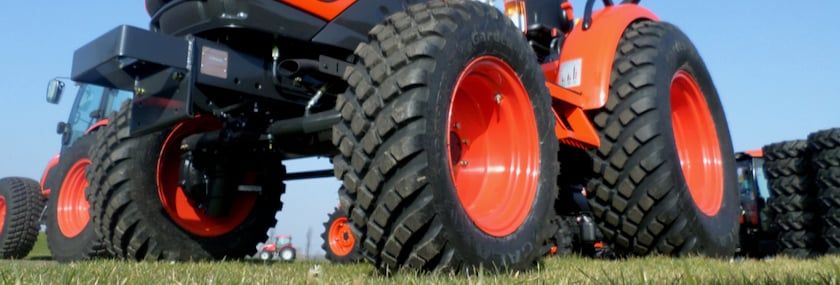6 Steps to the Right Tractor Tire


Getting the most from your tractor starts at ground level
It may be the bright paint job, strong lines, or powerful chug of the engine that grabs your attention, but when it comes to getting the most from your tractor, your tires are at the top of the list.

Tires help your tractor deliver its horsepower to the ground, gain traction for tough jobs, reduce soil compaction and damage to turf, stay safe, and they can protect your tractor from wear. Seletcting the right tires and maintaining them properly are critically important to getting jobs done around your acreage.
The first step in selecting the best tire is considering how you use your tractor.
Is it mostly for mowing? Pulling scrapers, rototillers or tillage tools? Hauling loads down the road or driveway Once you have thought that through, consider some of these choices.
Bias or radial?
Cars and trucks have been running on radials for about 50 years, but many tractor and implement tires are still made with old-fashioned bias-ply construction. (Online videos explain differences between radial and bias-ply construction.)
Bias-ply sidewalls are stiffer and tend to pull the edges of the tread up away from the ground, while more flexible radial sidewalls squat and allow under-tread belts to press the tread down for a large, even contact patch.
Consequently, radial tires tend to wear more evenly, get better traction, and deliver better fuel economy. Shock-absorbing radial sidewalls also create a more comfortable ride and reduce impacts that can stress machinery and operators.
For tractors doing simple chores, bias-ply can be a good, lower-cost option. For tractors needing to work harder, perform better, and ride smoother, radials deliver more.
Bar or block?
Compact tractor tires fall into several classes, including:
- R-1, the classic farm tractor design. Deep, curved lugs provide aggressive traction in mud and loose soil.
- R-3, called turf tires. Shallower tread patterns are usually made up of small blocks or diamonds. Turf tires are gentler on grass and forage, and great for mowing.
- R-4, the hockey-stick-shaped bar tread patterns typically seen at construction sites and other areas where they work on hard surfaces.

Some tire manufacturers have recently created "hybrid" treads for compact tractors—for instance, blocks that are deeper than turf tire treads and arranged in more widely spaced patterns inspired by curved R-1 lugs.
These hybrids strike a good balance between traction and turf protection, combining the extra biting edges of blocks with the more aggressive traction and self-cleaning action of agricultural tires.
Big gaps or small?
Wider spacing between blocks or lugs provides more traction, which is great in mud, sand or snow. On the other hand, less space between blocks or lugs—called a higher rubber-to-void ratio—resists wear on pavement and is less damaging to turf.
Sharp or rounded?
Look at the shoulder of the tire, where the tread meets the sidewall. Sharp shoulders provide extra traction and help eject mud, which is great in wet soil and snow. On your lawn, an aggressive shoulder can dig up divots or leave ruts, so a rounded shoulder would be a better choice.
Scrub or chunk?
Made not just of "rubber," every tire actually contains dozens of ingredients in complex formulas—called compounds— that help them perform their best in specific conditions.
A tractor run primarily on hard pavement and gravel needs a tread made from a hard, scrub-resistant or wear-resistant compound. If you operate more in the field, with rocks and stumps, look for a chunking-resistant or cut-and-chip compound that is softer but less prone to having hunks bitten out of the tread.
Under pressure?
The most important thing you can do is make sure you are operating them at the correct inflation pressure. Overinflated tires wear too quickly, especially in the center of the tread. Under-inflated tires can be unstable, roll off the rim or build up excessive heat…and catastrophic failure.

Every tire manufacturer creates tables that list the optimum air pressure for a particular maximum operating speed and load. They’re available from your tire dealer or online. Your tire dealer can also help you calculate the load on each tire, which includes not only the weight of the machine, but also the weight of accessories and cargo (like an arm, bucket and load of soil).
A few minutes spent determining proper air pressure and a few more working with an air compressor and tire gauge can protect hundreds of dollars' worth of tires and help keep you safe.
Click here to see the many differences in tires for small tractors
Tags:Tool Time

Acreage Life is part of the Catalyst Communications Network publication family.















